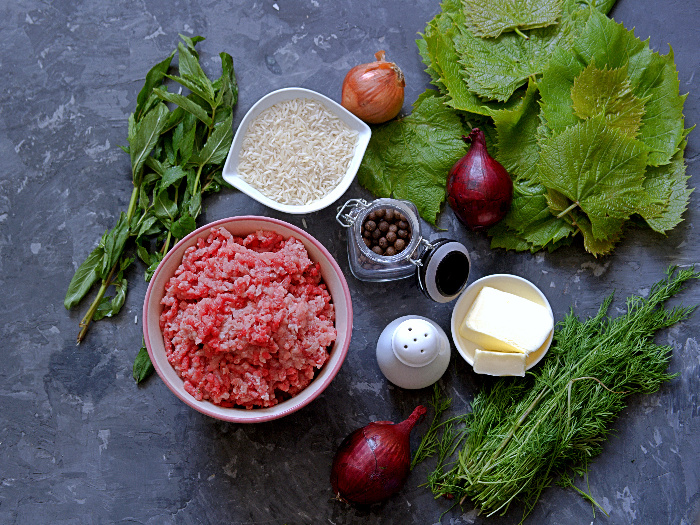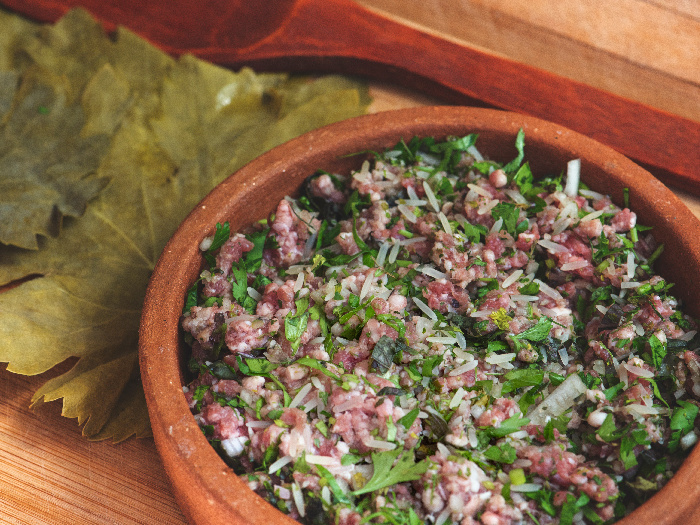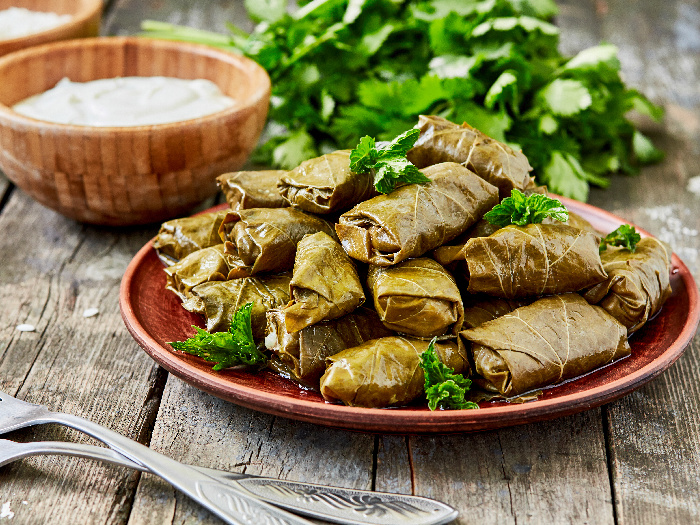Never was the ownership of a dish as disputed as dolma. The name may come from Turkey, but it is beloved all across the Middle Eastern and Mediterranian region with every country claiming it as its own. In Greece, it is known as dolmades and in Azerbaijan it is dolmasi. Whatever the location, dolma is a delicacy, prepared painstakingly and meant to be savored on special occasions. Even the rolling of the dolma is an occasion in itself. The Armenian dolma made all the way to the UNESCO Intangible Cultural Heritage Lists. It is one of those dishes that are so rooted in history and culture of a place that it cuts across cultural, linguistic, nationalistic, and religious barriers. In fact, dolma is one dish that unifies an otherwise deeply fractured region.
What is Dolma?
Dolma is a popular dish where spiced meat or rice is wrapped in a vine or cabbage leaves. The stuffed-leaves version is the most popular form of dolma. However, it is also made by stuffing a whole range of vegetables and fruits. This includes eggplants, tomatoes, onions, cucumbers, quinces, and apples. The word dolma may have its origin in the courts of the Ottoman empire, but many believe it predates the empire by many centuries. This dish has been made in some form or the other across this region.
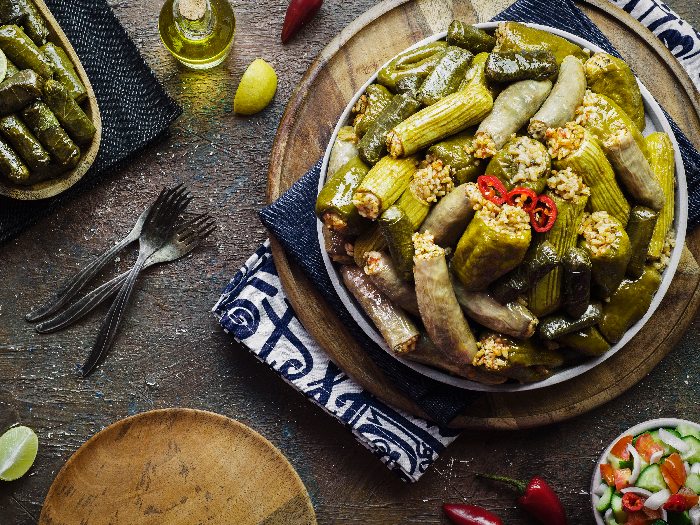
Stuffed dolmas. Photo Credit: Shutterstock
The dolma, no matter where the cook is from, follows an almost same procedure with regional and seasonal variations. The vines are stuffed with a mix of rice, meat, nuts, and spices. The vegetarian version (often jokingly called the ‘fake’ dolma) omits the meat. The rolled dolmas are often cooked in a tomato gravy. You can find sweet and sour versions, such as those made by Iraqi jews. The ancient Greeks made a sweet version with fig leaves and cheese.
Dolma also cuts across religious lines. In the Middle East, it is prepared in all festivals, no matter what the occasion. For instance, the Muslims make it during Ramadan and the Christians prefer the vegetarian version during Lent. It is a special celebratory dish during Norouz, the Iranian New Year.
How to Make Dolma?
Making dolma can take some time, but it can be curiously therapeutic. It is the perfect rainy day activity. Preparing the filling, rolling the leaves or stuffing the vegetables, and then cooking them is not something you can finish in a hurry. But, putting a plateful of dolmas for family and friends and watching them enjoy these morsels of joy is what every cook lives for!
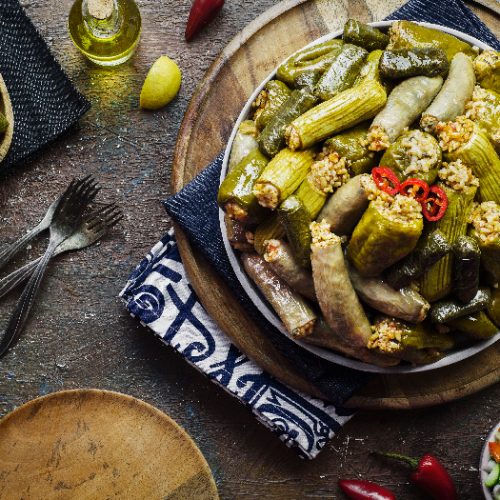
Traditional Dolma Recipe
Ingredients
- 2 onions minced
- 4 tbsp tomato paste
- 1/2 cups uncooked rice
- 2 tbsp pine nuts
- 2 tbsp currants
- 1/4 tsp allspice
- 1/4 tsp cumin
- 1/2 cup parsley
- 1/2 cup mint
- 1 tbsp dill chopped
- 1 pound beef or lamb or a combination minced
- 2 tbsp olive oil
- 1 jar grape leaves drained
- salt to taste
- 2 tsp ghee or butter
- 1/4 cup water plus for filling
For the yogurt sauce
- 1 cup Greek yogurt
- 2-4 garlic minced
- salt to taste
- 1 tsp olive oil
For the olive oil sauce
- 2/3 cup olive oil
- 4 tbsp lemon juice
- 1 tsp sugar optional
Instructions
- To make the stuffing, add all the ingredients (except the leaves) in a large bowl and mix thoroughly. Add a quarter cup water as well. Keep this aside.

- Take the leaves out of the can and immerse in hot water. Let them stay in for 10 minutes. Place the leaves in a colander and wash them in cold water to remove the salt.
- If the leaves seem too thick and unyielding, you can blanch them further for 10 minutes in hot water.
- Lay a leaf, with the shiny side down, atop a board. Cut out the stem. Place about a tablespoon of the stuffing at the base. Fold the overhanging bottom part over it. Fold in the sides of the leaves. Holding the base, start rolling till you have a neat cylindrical parcel of a stuffed leaf.

- Line a deep base pan with thicker or damaged leaves. This is to prevent the dolmas from sticking to the pan.
- Now start laying the rolled leaves seam-side down. Arrange the rolled parcels in layers. Dot it with butter or the ghee.
- Cover them with water, so that it reaches just the top of the stack of rolled leaves. If the rolled leaves reach only up to the middle of the pan, put a plate over the leaves and then pour in the water so that it reaches above the plate.
- Cover the pan and let it cook for at least an hour and a half. After they are cooked, take out the dolmas and arrange them on a platter.
- To serve, drizzle the dolmas with the sauce of your choice. You can serve the sauce alongside. For an easy and quick sauce, follow any one of our recipes.
Yogurt sauce
- Mix the minced garlic and olive oil with the yogurt and give it a stir. Taste the sauce and add the salt if needed.
Olive oil sauce
- In an airtight jar, add the salt and lemon juice. Close the lid and give the jar a quick shake. The sauce is ready. If you are storing the sauce, give the jar a brisk shake before serving.

Notes
- You can make a vegetarian version by removing the meat and increasing the quantity of rice to a cup-and-half.
- Some people like to cook their dolma in a tomato sauce. For this, pour a can of tomato sauce to the dolma stack in the pan. Let the dolmas cook in this sauce.
We have offered a traditional dolma recipe, which can be easily adapted for vegetarians. Some other tips you should keep in mind:
- You can prepare a vegetarian or a meat stuffing as per your taste or preferences. When cooking for a large group, you may want to include both for individual tastes.
- We have used the traditional vine leaves for the recipe. However, dolmas can be cooked with other vegetables such as peppers, pointed gourd or zucchini. You can even make a platter of different vegetables for a special meal.
- To stuff vegetables, you need to ‘hollow’ them. For instance, cut out the top of a pepper and stuff the hollow cavity with the filling. For a tomato, cut the top and remove all the pulp. Vegetables like eggplants or zucchini will need to be hollowed out with a knife.
- Some people add the vegetable pulp to the stuffing for zero wastage.
- Make sure all the ingredients in the stuffing are minced or chopped fine. You can use a food processor for this. You can be creative here and include vegetables not mentioned in our recipes, such as mushrooms and fennel.
- Some people like to cook their dolma in a tomato sauce. For this, pour a cup of tomato sauce to the dolma stack in the pan. Let the dolmas cook in this sauce.
- As mentioned above, dolma fillings have many variations, including sweet cheese stuffing. Go ahead and experiment with other flavors and ingredients.
How to eat it: Bursting with flavor, dolmas are perfect finger food. Just pick up one roll and finish it in two bites! However, for a formal occasion or sit-down dinner, you may want to mind your manners and use a knife and fork. We recommend you take the cue from your surroundings. Dolmas are usually served with a yogurt or olive oil sauce. Those cooked in tomato sauce are served with the reduced sauce. Vegetarian dolmas are often eaten cold. However, the meat-filled dolma is eaten warm.
So, start making dolmas and share your experience with us. If you have a different recipe for the stuffing, share it with us. We would love to hear from you. If you love Middle-Eastern food, read more about the food from the region.
